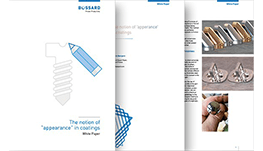The purpose of coatings is not just to protect your components from external influences, but also to safeguard the environment from certain substances in your components. If this two-way protection is to be preserved, the thickness of the coatings must be suitable first and foremost. This is why it is advisable to check them regularly and have them remeasured in a technical testing laboratory by means of layer thickness measurements.
Measurement of coating thickness in the testing laboratory
Which coating you choose for your components depends on various factors: Which environment are the parts used in? What environmental influences affect the parts? Reliable processes are absolutely vital to ensure that neither your component nor the environment come to any harm. One of these processes is layer thickness measurement, which Bossard carries out in accredited testing laboratories. Up to three layers on your metallic component are precisely measured with the aim of detecting any defects as early as possible and thus ensuring the quality of the components and that they are working properly.
What is a layer thickness measurement and which methods are available?
Coatings are found on a wide variety of components nowadays. Single or multiple coatings ensure that your components meet specific physical or chemical requirements. The applied layers not only need to have a certain hardness and adhesive strength; the coating’s thickness is also critical, too. If it is too thin, the entire coating can fail. This causes undesirable reactions between the surface and the environment. Coatings are found on a wide variety of components nowadays. Single or multiple coatings ensure that your components meet specific physical or chemical requirements. The applied layers not only need to have a certain hardness and adhesive strength; the coating’s thickness is also critical, too. If it is too thin, the entire coating can fail. This causes undesirable reactions between the surface and the environment.
To prevent this, you should have regular layer thickness measurements conducted in a testing laboratory. The layer thickness is measured, you learn exactly how thick a coating is and you therefore obtain information about the quality of your components.
Layer thickness measurement 101
Which measurement method is most suitable for measuring your components’ layer thickness usually depends on the base material and its coating. For example, when dealing with multi-coated metallic components, X-ray fluorescence (XRF) analysis can provide precise results on layer thicknesses and compositions. When using this measurement method, a sample is exposed to targeted X-rays. The radiation energy causes the electrons in the atom to leave their original position and be replaced by atoms from higher layers. The material subsequently gives off characteristic X-ray fluorescence radiation. The experts measure this radiation and determine the thickness of up to three different layers.
Bossard – precise metal layer thickness measurement in the testing laboratory
Bossard focuses on X-ray fluorescence analysis in its accredited testing laboratories. It is a non-destructive method that provides precise and targeted layer thickness measurements despite the short time it takes.
In our testing laboratories, we therefore test the required protective metal layer thicknesses of:
- components with up to three layers; and
- coatings consisting of zinc, nickel, chrome, zinc flake, gold, silver and many more metals besides.
Contact our experts to find out more about Bossard’s Expert Test Services. We look forward to hearing from you!
Discover other modules that contribute to improving your productivity step by step
![]() Expert Education
Expert Education
Learn about the essentials and secrets of fastenings in our seminars and e-learning courses
![]() Expert Teardown
Expert Teardown
Identify the best fastening solution and cost saving potential for you
![]() Expert Design
Expert Design
Design your best product with a wide range of technical information and tools
Expert Walk
Study your fasteners and tools in use, we determine how to proceed leaner and smarter
![]() Expert Assortment Analysis
Expert Assortment Analysis
Reduce TCO by identifying opportunities for fastener rationalization


